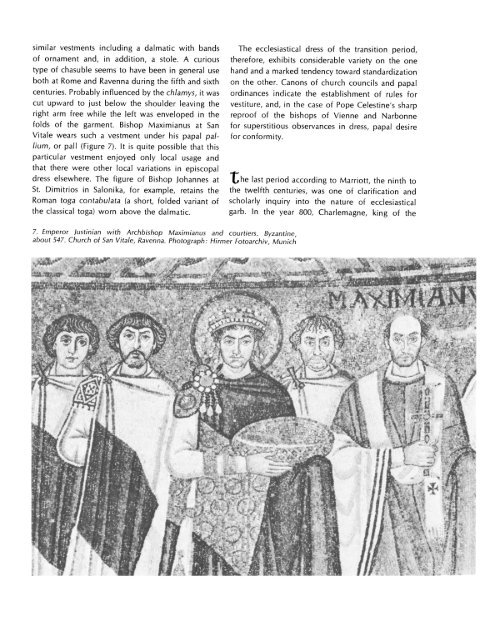The Metropolitan Museum of Art Bulletin, v. 29, no. 7 (March, 1971)
The Metropolitan Museum of Art Bulletin, v. 29, no. 7 (March, 1971)
The Metropolitan Museum of Art Bulletin, v. 29, no. 7 (March, 1971)
Create successful ePaper yourself
Turn your PDF publications into a flip-book with our unique Google optimized e-Paper software.
similar vestments including a dalmatic with bands<br />
<strong>of</strong> ornament and, in addition, a stole. A curious<br />
type <strong>of</strong> chasuble seems to have been in general use<br />
both at Rome and Ravenna during the fifth and sixth<br />
centuries. Probably influenced by the chlamys, it was<br />
cut upward to just below the shoulder leaving the<br />
right arm free while the left was enveloped in the<br />
folds <strong>of</strong> the garment. Bishop Maximianus at San<br />
Vitale wears such a vestment under his papal pallium,<br />
or pall (Figure 7). It is quite possible that this<br />
particular vestment enjoyed only local usage and<br />
that there were other local variations in episcopal<br />
dress elsewhere. <strong>The</strong> figure <strong>of</strong> Bishop Johannes at<br />
St. Dimitrios in Salonika, for example, retains the<br />
Roman toga contabulata (a short, folded variant <strong>of</strong><br />
the classical toga) worn above the dalmatic.<br />
<strong>The</strong> ecclesiastical dress <strong>of</strong> the transition period,<br />
therefore, exhibits considerable variety on the one<br />
hand and a marked tendency toward standardization<br />
on the other. Ca<strong>no</strong>ns <strong>of</strong> church councils and papal<br />
ordinances indicate the establishment <strong>of</strong> rules for<br />
vestiture, and, in the case <strong>of</strong> Pope Celestine's sharp<br />
repro<strong>of</strong> <strong>of</strong> the bishops <strong>of</strong> Vienne and Narbonne<br />
for superstitious observances in dress, papal desire<br />
for conformity.<br />
lthe last period according to Marriott, the ninth to<br />
the twelfth centuries, was one <strong>of</strong> clarification and<br />
scholarly inquiry into the nature <strong>of</strong> ecclesiastical<br />
garb. In the year 800, Charlemagne, king <strong>of</strong> the<br />
7. Emperor Justinian with Archbishop Maximianus and courtiers. Byzantine,<br />
about 547. Church <strong>of</strong> San Vitale, Ravenna. Photograph: Hirmer Fotoarchiv, Munich

















